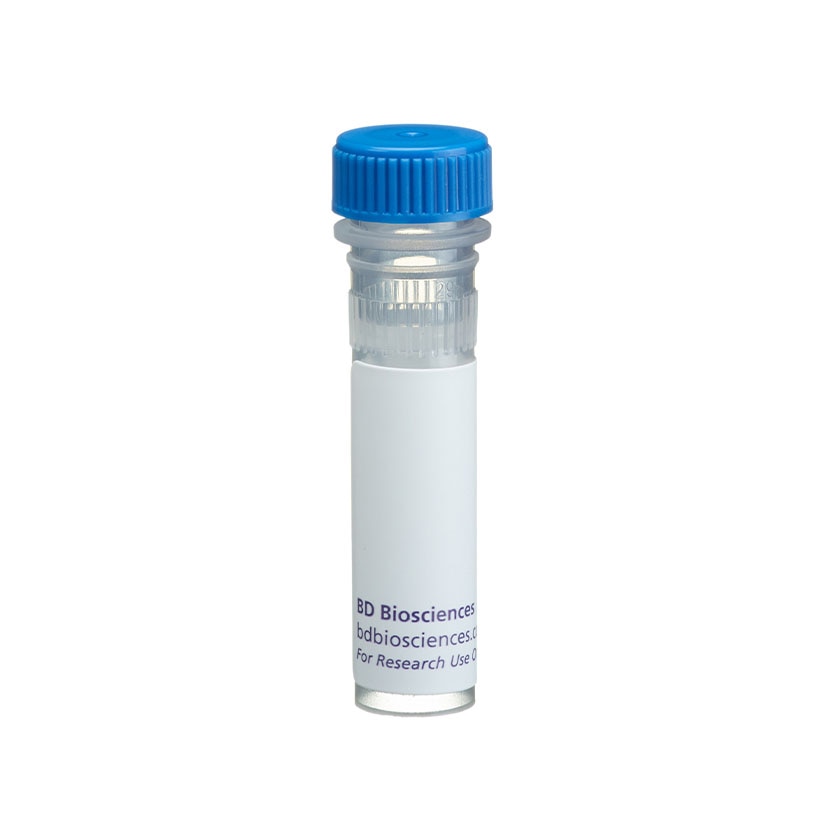Old Browser
This page has been recently translated and is available in French now.
Looks like you're visiting us from {countryName}.
Would you like to stay on the current country site or be switched to your country?




Profile of M21 human melanoma cells analyzed by flow cytometry using clone 9.2.27 (Cat. No. 554275). Cells were incubated with either Purified Mouse anti-Chondroitin Sulfate or Purified Mouse IgG2a, κ Isotype Control, and detected with a FITC conjugated second step antibody (Cat. No.555988).


BD Pharmingen™ Purified Mouse Anti-Chondroitin Sulfate

Regulatory Status Legend
Any use of products other than the permitted use without the express written authorization of Becton, Dickinson and Company is strictly prohibited.
Preparation And Storage
Recommended Assay Procedures
Clone 9.2.27 specifically reacts with a chondroitin sulfate proteoglycan. By immunoprecipitation, it recognizes the fully processed 250 kDa core glycoprotein and a set of precursor polypeptides (210 kDa, 220 kDa, and 240 kDa).
Applications include immunoprecipitation (1 µg/1x10^6 cells), flow cytometry (1-2 µg/ 1x10^6 cells) and immunoflourescence microscopy of cultured cells.
Product Notices
- Since applications vary, each investigator should titrate the reagent to obtain optimal results.
- Please refer to www.bdbiosciences.com/us/s/resources for technical protocols.
- Caution: Sodium azide yields highly toxic hydrazoic acid under acidic conditions. Dilute azide compounds in running water before discarding to avoid accumulation of potentially explosive deposits in plumbing.
- Sodium azide is a reversible inhibitor of oxidative metabolism; therefore, antibody preparations containing this preservative agent must not be used in cell cultures nor injected into animals. Sodium azide may be removed by washing stained cells or plate-bound antibody or dialyzing soluble antibody in sodium azide-free buffer. Since endotoxin may also affect the results of functional studies, we recommend the NA/LE (No Azide/Low Endotoxin) antibody format, if available, for in vitro and in vivo use.
- An isotype control should be used at the same concentration as the antibody of interest.
- For fluorochrome spectra and suitable instrument settings, please refer to our Multicolor Flow Cytometry web page at www.bdbiosciences.com/colors.
The 9.2.27 monoclonal antibody specifically binds to CSPG4 (chondroitin sulfate proteoglycan 4). CSPG4 is also known as MCSP (melanoma chondroitin sulfate proteoglycan) and NG2 (neural/glial antigen 2). The hybridoma secreting the 9.2.27 antibody was generated using a human melanoma cell extract as the immunogen. Tumor cells display a variety of antigens which have been defined by antibodies. Antibodies that specifically react with tumor-associated antigens are useful in understanding the biology of particular tumor types. Proteoglycans including chondroitin sulfate, keratan sulfate, dermatan sulfate and heparan sulfate are major components of the extracellular matrices of many animal cell types. Clone 9.2.27 has been shown to react with human melanoma cells, glioma cells, and proliferating brain endothelial cells. It did not react with fetal melanocytes, neuroblastoma LA-N-1 cells or a variety of carcinoma, lymphoid, and fibroblastoid cell lines. Additionally, neither white nor gray matter from the medulla oblongata, cerebellum or spinal cord of a normal human adult reacted with 9.2.27. Clone 9.2.27 has also been used in functional studies to investigate the role of chondroitin sulfate proteoglycans in human tumor cell systems. It has been shown to block melanoma cell spreading, exhibit antiproliferative effects on glioma cells in vitro and suppress glioma tumor growth in athymic nude mice models.
A soluble extract derived from M14 human melanoma cells bound to lens culinaris lectin-Sepharose and depleted of fibronectin was used as immunogen.
Development References (6)
-
Bumol TF, Reisfeld RA. Unique glycoprotein-proteoglycan complex defined by monoclonal antibody on human melanoma cells. Proc Natl Acad Sci U S A. 1982; 79(4):1245-1249. (Biology). View Reference
-
Bumol TF, Walker LE, Reisfeld RA. Biosynthetic studies of proteoglycans in human melanoma cells with a monoclonal antibody to a core glycoprotein of chondroitin sulfate proteoglycans. J Biol Chem. 1984; 259(20):12733-12741. (Clone-specific: Electron microscopy, Immunofluorescence, Immunoprecipitation). View Reference
-
Cheresh DA, Honsik CJ, Staffileno LK, Jung G, Reisfeld RA. Disialoganglioside GD3 on human melanoma serves as a relevant target antigen for monoclonal antibody-mediated tumor cytolysis. Proc Natl Acad Sci U S A. 1985; 82(15):5155-5159. (Biology). View Reference
-
Morgan AC, Galloway DR, Reisfeld RA. Production and characterization of monoclonal antibody to a melanoma specific glycoprotein. Hybridoma. 1981; 1(1):27-36. (Immunogen: Immunoprecipitation). View Reference
-
Schrappe M, Bumol TF, Apelgren LD. Long-term growth suppression of human glioma xenografts by chemoimmunoconjugates of 4-desacetylvinblastine-3-carboxyhydrazide and monoclonal antibody 9.2.27. Cancer Res. 1992; 52(14):3838-3844. (Clone-specific: Immunofluorescence). View Reference
-
Spiro RC, Casteel HE, Laufer DM, Reisfeld RA, Harper JR. Post-translational addition of chondroitin sulfate glycosaminoglycans. Role of N-linked oligosaccharide addition, trimming, and processing. J Biol Chem. 1989; 264(3):1779-1786. (Biology). View Reference
Please refer to Support Documents for Quality Certificates
Global - Refer to manufacturer's instructions for use and related User Manuals and Technical data sheets before using this products as described
Comparisons, where applicable, are made against older BD Technology, manual methods or are general performance claims. Comparisons are not made against non-BD technologies, unless otherwise noted.
For Research Use Only. Not for use in diagnostic or therapeutic procedures.
Report a Site Issue
This form is intended to help us improve our website experience. For other support, please visit our Contact Us page.
